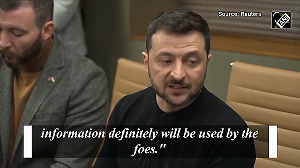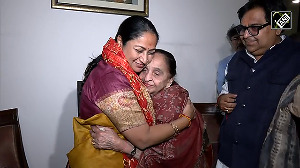Dr Raja Ramanna, the architect of India's nuclear programme, has left an indelible imprint on India's scientific map.
Ramanna, who died early on Friday, had led a Bhabha Atomic Research Centre team to conduct the country's first nucear test at Pokhran, Rajasthan, in 1974.
| |||||||||||
A recipient of Padma Vibhushan, Ramanna was also a member of the Rajya Sabha till last year. He founded the National Institute of Advanced Studies in Bangalore.
The pinnacle of his glory, however, was India's first nuclear explosion at Pokhran, which took the world by storm.
Born in 1925 at Tumkur, Karnataka, Ramanna graduated from the Madras University. He later left for the United Kingdom where he completed his PhD. He returned to India and joined Homi Bhabha, who was then at the Tata Insititute of Fundamental Research.
Ramanna occupied the posts of vice-chairman of the council of management at the National Institute of Advanced Studies (Bangalore), chairman of the governing council of the Indian Institute of Science, Bangalore; and chairman of council of management of the Jawaharlal Nehru Centre for Advanced Scientific Research.
He was president of the Indian National Science Academy from 1977 to 1978.
Winner of several awards, including the Shanti Swarup Bhatnagar Memorial Award, Nehru Award, R D Birla Memorial Award and the Meghnad Saha Medal, he was awarded a honorary Doctor of Literature by the Viswa Bharati and DSc by several universities.
Ramanna was also the member-chairman of the Scientific Advisory Committee to the Director General, International Atomic Energy Agency, and presided over the 30th General Conference of the IAEA.
A multi-faceted personality, the renowned nuclear scientist could play both the piano and viola as dexterously and passionately as he could speak about atomic energy. Playing the piano, which he said he started at the age of six, was a passion. He also played at several concerts.
His explanations about the notes of his viola to the audience were also well-appreciated in music circles. Not surprisingly, one of the two books that he authored was on music - "The Structure of Music in Raga and Western Systems". His other book was "Years of Pilgrimage: An autobiography".
Ramanna was the director-emeritus of the Bangalore-based National Institute of Advanced Studies and was a stimulant to young minds besides being a fine human being.
He is survived by his wife, two daughters and a son.
Also read:






 © 2025
© 2025